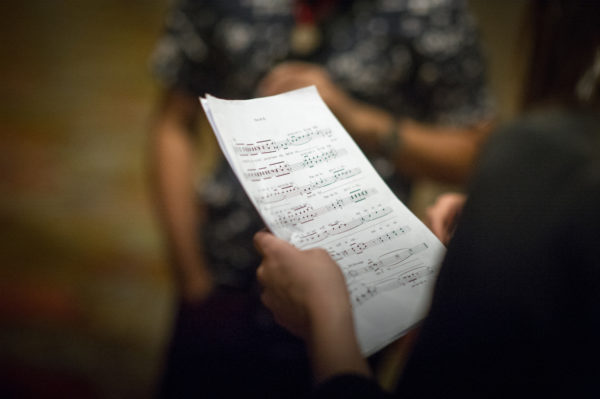As featured in The Harmonizer.
Learn to Sight-Sing
I make a promise to my students at the beginning of every school year: you will not leave my classroom being musically illiterate. Music is the universal language, and it’s of utmost importance that we “speak” it!
You learned to read by first recognizing letters of the alphabet and the sounds they make. Next you learned to combine them into words, sentences, and phrases. Likewise, you can learn to recognize notes on a music staff, find common patterns in music, and breath life into the pages of black and white, turning them into real music!
Sight-singing methods. Research suggests that no method is necessarily better than another. Find one that makes the most sense to you! To help get you started, I’ll introduce the system and sequencing I use with my students.
Gotta know where’s do!
Sight-singing is based on relationships. Know where one note is and you can find the rest. Solfege is a system of syllables to help recall these relationships. Others find success using numbers. In Solfege, the tonic pitch is called do (dough). Use your pitch pipe or keyboard to play Bb. Sing that pitch in your lowest comfortable octave calling it do.
Educators and directors: One key benefit of solfege is vowel reinforcement.
Insist on pure vowels!

Exercise 1: Sing up and down the scale using the diagram of syllables (upper left) and mimic the hand signs. Repeat until you’re comfortable with the syllables and hand-signs.
Educators and directors: hand signs relate the music kinesthetically. It’s important that hand signs move up and down in relationship to the body to reinforce pitches going higher and lower. Your singers can also make the hand signs as they sing.
Exercise 2: Sing the solfege patterns on the bottom left. Use a comfortable tempo and sing each note accurately on a steady beat using the hand signs. (d=do, r=re, etc. Capital means high Do).
Educators and directors: these types of exercises allow singers to focus on sound and pitch relations. Later, singers will associate what they’ve already experienced with how it looks on the staff. For more exercises like this, consider writing your own. Use patterns found in the repertoire you’re learning.
The benefits of sight-singing:
• learn music faster
• increased ability to sing difficult music
• improved recall ability
• better awareness of the ensemble’s notes
• better tuning skills (highly valuable in barbershop!)
• improved performance abilities
• understand what you hear
• hear what you see
• more musical freedom
The music staff
Now that you’re comfortable with solfege syllables, let’s explore how they look in sheet music. Musicians use a system of 5 lines and 4 spaces, called a staff, to represent how high or low we’ll sing.
Exercise 3: Sing the same exercises as before, but seen on the music staff, as below. do is assigned to one of the lines or spaces at the beginning of each melody. Sing each in a key comfortable for your voice. Remember your hand signs!
Educators and directors: there are no meter markings, stems, or key signatures in these exercises, to give singers the chance to focus on only one new skill. Give your singers time to think by taking a slow and steady tempo at about 60 BPM.
Moving forward
You are on your way to music literacy! With limited space, I won’t be able to take you through an entire school year’s worth of sight-singing. So what’s next? I suggest using the following sequence:
• Singing up and down the scale
• Add familiar rhythms (eighth-note pairs, half notes, etc.)
• Interval skips built on the tonic chord (do, mi, and so)
• Key signatures, finding the tonic pitch, and meters
• Interval skips built on the Dominant Chord (so, ti, re, and fa)
• Interval skips built on the Subdominant Chord (fa, la, and do)
• Altered pitches (sharps, flats, and naturals)
The outline above represents a thorough curriculum from basic music knowledge to familiarity. It does take commitment and time, but is worth the effort! If you can commit only 5 minutes a day, you’ll be a better sight-singer, and a better musician, in no time.
Other resources include MusicTheory.net, SightReadingFactory.com, and “Eyes and Ears – An Anthology of Melodies for Sight-singing,” a free downloadable
book online. Or multiple other sight-singing books in print (my favorite is The Jenson SightSinging Course Vol. 1).
Conclusion
I love to sight-sing, and I love teaching sight-singing. I hope you’ve found some nuggets of wisdom to help in your journey, or the inspiration to learn the basics of becoming a literate musician. And most of all, I wish you happy
music making as we continue our work of making a better world through harmony.
-Peter Cunningham (pbcunningham824@gmail.com) is choir
Director of James Madison High School in San Antonio. He sings
lead with The Academy, (2014 Youth Quartet Champion),
Southern Stride, The Standard, and The Marcsmen.
